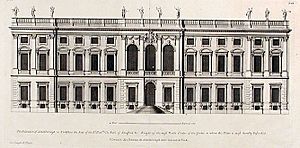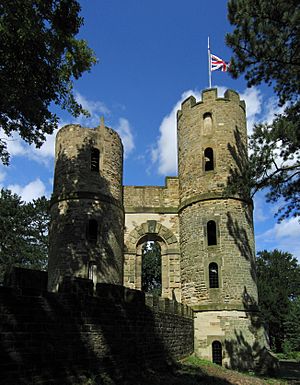Wentworth Castle facts for kids
Wentworth Castle is a grand country house located in Stainborough, near Barnsley in South Yorkshire, England. It's a very important historical building, listed as Grade I, which means it's one of the most significant buildings in the country. For many years, it was the home of the Earls of Strafford, a powerful family. Today, it is home to the Northern College, a place where adults can study.
The land where Wentworth Castle stands was once called Stainborough. An older house was already there when Thomas Wentworth, who later became the Earl of Strafford, bought the estate in 1708. The name of the estate was changed to Wentworth Castle in 1731. You can still find the old name in "Stainborough Castle," which is a fake ruin built in the gardens just for fun!
From 2001 to June 2019, the Wentworth Castle Heritage Trust looked after the estate. The gardens were open to visitors for many years. However, in 2017, the gardens had to close because they ran out of money, even after a lot of restoration work. Good news came in September 2018 when the National Trust announced plans to work with Northern College and Barnsley Council to reopen the gardens. The beautiful gardens and parkland officially reopened to the public on June 8, 2019.
Contents
History of Wentworth Castle
The story of Wentworth Castle began with an older house, built in 1670 for Sir Gervase Cutler. Sir Gervase later sold the estate to Thomas Wentworth, who became the 1st Earl of Strafford. The house was changed and made much grander in two big building projects, led by two different Earls, each for interesting reasons.
First Big Building Project
The first major upgrade to the house started around 1711. This was led by Thomas Wentworth, Baron Raby, who later became the 1st Earl of Strafford (the second time this title was created).
Thomas Wentworth felt that the nearby Wentworth Woodhouse estate should have been his. This made him want to make his own home, Stainborough Castle, even more splendid than Wentworth Woodhouse. He wanted to show off his family's importance and good taste.
Wentworth was a soldier for King William III and later an ambassador for Queen Anne. After Queen Anne died, he and his political party (the Tories) lost power. So, Wentworth spent his retirement making his grand house and its gardens even more impressive.
He bought paintings for his new house in Italy in 1709, hoping to have a better collection than his rivals. To show off these paintings, a huge gallery was needed. This gallery was finished in 1724. It was 180 feet long, 24 feet wide, and 30 feet high! It had fancy marble columns and pilasters (flat columns) with gold tops.
By 1714, the building was well underway. Thomas Wentworth chose large glass panes for the windows, which was a very modern choice for the time. The east side of the house was described as having "palatial splendour," meaning it looked like a palace. The main rooms on the ground floor were decorated with paintings on the ceilings.
The design of the east side of Wentworth Castle was quite unique in Britain. It looked like a mix of French and Prussian styles. This grand front faced a raised terrace with gravel paths and a grotto (a small cave-like structure). Beyond this, there were long rows of trees leading to a fancy iron gate. These formal gardens were later changed to a more natural, open landscape.
The First Earl's Gardens
Thomas Wentworth, the 1st Earl of Strafford, planted many trees in the open countryside around his home. He also built a fake castle ruin, called "Stainborough Castle," between 1726 and 1730. This ruin was placed on the highest point of the estate and was one of the first fake castles used as a decorative feature in an English garden. Its four towers were named after his four children. A statue of the Earl himself, made in 1730, was placed in the central court of the ruin, but it has since been moved closer to the main house.
In 1734, an obelisk (a tall, thin monument) was put up to remember Queen Anne. A room in the house was even called "Queen Anne's Sitting Room." Many other garden features were added over time, and today, there are twenty-six historical structures still standing in the park.
The 2nd Earl at Wentworth Castle
The 1st Earl died in 1739, and his son, William Wentworth, became the 2nd Earl of Strafford. William was very interested in architecture and designed the beautiful new part of the house, built between 1759 and 1764. He traveled around Europe to improve his taste in art and design. He preferred to focus on his home rather than politics.
William Wentworth worked closely with skilled builders and designers. It was well known that he was his "own architect," meaning he designed most of it himself. Even the famous writer Horace Walpole praised Wentworth Castle, saying it was a perfect example of beautiful architecture. Walpole said the house had "grace" and "dignity" and that its location and even the color of the stone were perfect. He called the estate a "compendium of picturesque nature," meaning it was a perfect mix of natural beauty and careful design.
Later Years of Wentworth Castle
After the 3rd Earl of Strafford died in 1799, the family's huge estates were divided. Wentworth Castle went to Frederick Vernon, a grandson of the 1st Earl's daughter. Frederick Vernon added "Wentworth" to his name and took over the estate in 1816. Between 1820 and 1840, he replaced the old chapel and made changes to the house's windows and rooms. In July 1838, a strange hailstorm damaged the house's roof and windows, as well as the greenhouses.
In May 1853, an unusual snowstorm also caused a lot of damage, especially to the old trees in the gardens. Frederick Vernon was followed by his son Thomas in 1885. Thomas added a glass conservatory and electric lighting to the house. A new part of the house, called the Victorian Wing, was also built around this time. This allowed the family to host important guests, including the young Prince Albert Victor, in the late 1880s. In 1902, Captain Bruce Vernon-Wentworth inherited the estate. He preferred his other homes and sold many valuable items from Wentworth Castle in 1919 after the First World War.
Captain Bruce Vernon-Wentworth, who had no children, sold the house and its gardens to Barnsley Corporation (the local council) in 1948. The rest of his estates went to a distant cousin. The remaining items in Wentworth Castle were sold, and the house became a college for training teachers until 1978. After that, it became home to Northern College.
The beautiful gardens that Horace Walpole praised in the 1700s had become damaged over time. However, from 2002 to 2017, Wentworth Castle Gardens, which are the only Grade I-listed parkland in South Yorkshire, received £20 million for restoration. The Wentworth Castle Heritage Trust was created in 2002 to restore the gardens and open them to the public. The Rotunda, a round building, was restored in 2010, and the parkland was returned to a deer park.
The estate fully opened to visitors in 2007 after the first phase of restoration. More restoration work was finished in 2014.
Wentworth Castle was even featured on the BBC TV show Restoration in 2003. There was a plan to restore the Victorian conservatory, a large glasshouse, but it didn't win the public vote. However, the Heritage Trust later raised £3.7 million to restore the conservatory, and work began in 2012. The restoration was completed in October 2013, and it reopened to the public in November 2013.
Even though many people visited, Wentworth Castle Gardens had to close in the spring of 2017 due to funding issues. During the closure, a small team of gardeners and volunteers kept the gardens maintained.
In September 2018, the National Trust announced a new partnership with Northern College and Barnsley Council to reopen the gardens and parkland in 2019. On Saturday, June 8, 2019, the gardens and parkland officially reopened under the care of the National Trust. The site is now open almost every day of the year. This partnership also helps to organize cultural and environmental events at Wentworth Castle and other places managed by Barnsley Museums.
See also
- Grade I listed buildings in South Yorkshire
- Listed buildings in Stainborough




